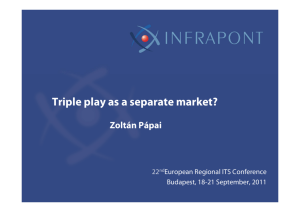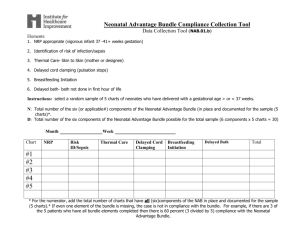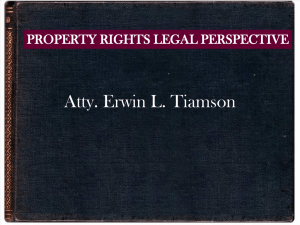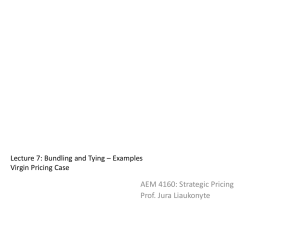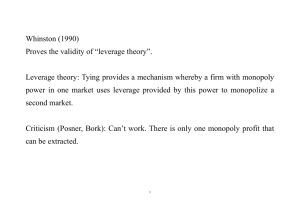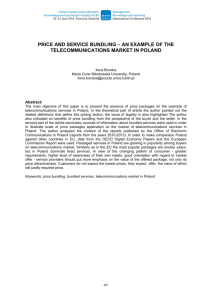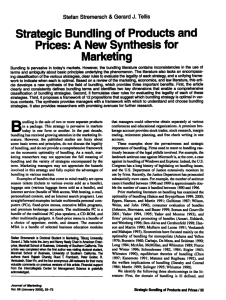MANAGERIAL ECONOMICS
advertisement
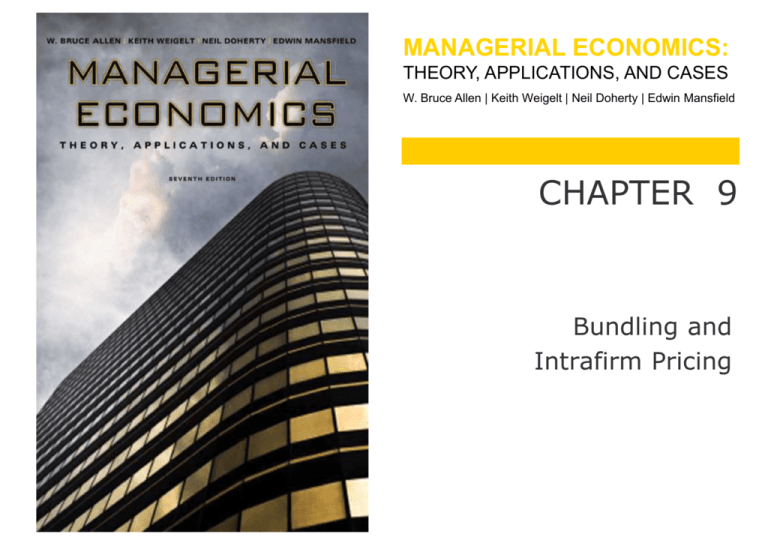
MANAGERIAL ECONOMICS: THEORY, APPLICATIONS, AND CASES W. Bruce Allen | Keith Weigelt | Neil Doherty | Edwin Mansfield CHAPTER 9 Bundling and Intrafirm Pricing OBJECTIVES • Explain how managers can use bundling and tying strategies to increase profit when customers have heterogeneous tastes • Explain how firms use transfer pricing to provide incentives to subsidiaries and divisions and to shelter profit from taxes in a global environment 2 Simple bundling: • When managers offer several products or services as one package so consumers do not have an option to purchase package components separately • TV channels • CD as compared to a single • Restaurant Fixed Menu (maybe mixed) • Sports tickets 3 Mixed bundling: • Allows consumers to purchase package components either as a single unit or separately • The bundle price is generally less than the sum of the prices of the individual components. • Examples: • Season tickets to sporting events • Typical Restaurant • Quantity discount 4 Conditions for bundling • Negative correlation of demand: When some customers have higher reservation prices for one item in the bundle but lower reservation prices for another item in the bundle, whereas another group of customers has the reverse preferences • Marginal costs for production should be low 5 Advantages of bundling • Bundling can increase the seller’s profit as customers have varied tastes. • Bundling can come close to first-degree price discrimination when it is not otherwise possible because individual reservation prices cannot be determined or laws prohibit price discrimination. • Bundling does not require knowledge of individual consumers’ reservation prices, but only the distribution of consumers’ reservation prices. 6 Strategies • Assumption: Goods are independent, so the value of a bundle is equal to the sum of the reservation prices of the goods in the bundle. • Separate pricing: Goods are not bundled. • Prices are set equal to profit-maximizing monopoly prices. • Pure bundling • Bundle price is set to maximize profit. • Mixed bundling • Bundle price and individual good prices are set to maximize profit. • Optimal strategy is one of the three 7 THE MECHANICS OF BUNDLING • Notation • ri = Reservation price of good i • (Willingness-to-pay WTP) • pi# = Price charged for good i • PB# = Price of bundle 8 Consumers compare WTP and price • Figure 9.1: Price Separately •If r1 < p1# and r2 < buys neither good. •If r1 > p1# and r2 < buys only good 1. •If r1 < p1# and r2 > buys only good 2. •If r1 > p1# and r2 > buys both goods. p2#, then consumer p2#, then consumer p2#, then consumer p2#, then consumer 9 10 THE MECHANICS OF BUNDLING • Figure 9.2: Pure Bundling • If (r1 + r2) < PB#, then consumer does not buy the bundle. • If (r1 + r2) > PB#, then consumer buys the bundle. 11 12 THE MECHANICS OF BUNDLING • Figure 9.3: Mixed Bundling • Buy neither good nor bundle: (r1 + r2) < PB#, r1 < p1#, and r2 < p2# • Buy bundle: (r1 + r2) > PB# • Buy good 1 only: r1 > p1#, r2 < p2#, and r2 < (PB# – p1#) • Buy good 2 only: r2 > p2#, r1 < p1#, and r1 < (PB# – p2#) 13 14 Start with some examples • Example 1 • Assumptions • Perfect negative correlation among consumer reservation prices • No variation in total bundle valuation; all indiv. value the bundle at $100. • Unit cost of production for each good = $1. • Table 9.1: Consumer Reservation Prices • Table 9.2: Optimal Separate Prices for Good 1 and Good 2: Profit = $264 15 16 17 Example 1 • Table 9.3: Optimal Pure Bundle Price for Consumers A, B, C, and D: Profit = $392 • Table 9.4: Optimal Mixed Bundle Prices: Profit = $392 • Table 9.5: Optimal Mixed Bundle Prices When Consumers Buy Bundle and at Least One of the Separately Priced Goods: Profit = $373.98 18 19 20 • Trick: try a price slightly above and below 90. • Same arguments will be valid for other prices 21 Criteria for successful bundling • Credibility of the bundle: When managers correctly anticipate which customers will purchase the bundle or the goods separately • Extraction: When the manager extracts the entire consumer surplus from each customer • Exclusion: When the manager does not sell a good to a customer who values the good at less than the cost of producing it • Inclusion: When a manager sells a good to a consumer who values the good at greater than the seller’s cost of producing the good 22 Successful bundling • Extraction, exclusion, and inclusion are all satisfied by perfect price discrimination. • Pricing separately will satisfy exclusion but will not result in complete extraction or inclusion. 23 Successful bundling • Pure bundling can result in complete extraction, but if consumer reservation prices do not have a perfect negative correlation, extraction will be less than complete. It is also possible for pure bundling to fail to attain full inclusion and exclusion. • The profit from mixed bundling is always equal to or better than that of pricing separately or pure bundling. • Problem: mixed bundling prices are difficult to find 24 The importance of costs • Example 2 • Assumptions • Perfect negative correlation among consumer reservation prices • No variation in total bundle valuation; all value the bundle at $100. • Now: • Unit cost of production for each good = $11. 25 Example 2 • Table 9.6: Optimal Separate Prices for Good 1 and Good 2: Profit = $204 • Table 9.7: Optimal Pure Bundle Price for Consumers A, B, C, and D: Profit = $312 • Table 9.8: Optimal Mixed Bundle Prices: Profit = $312 • Table 9.9: Optimal Mixed Bundle Prices When Consumers Buy Bundle and at Least One of the Separately Priced Goods: Profit = $313.98 26 27 28 29 30 Example 3 • Assumptions • Perfect negative correlation among consumer reservation prices • No variation in total bundle valuation; all value the bundle at $100. • Now • Unit cost of production for each good = $55. 31 Example 3 • Table 9.10: Optimal Separate Prices for Good 1 and Good 2: Profit = $70 • Table 9.11: Optimal Pure Bundle Price for Consumers A, B, C, and D: Profit = $ -40 • Table 9.12: Optimal Mixed Bundle Prices (pure bundle price will be higher than $100 (So no bundle is purchased): Profit = $70 32 33 34 35 The importance of costs • Conclusions from Examples 1–3: (Reservation prices are negatively correlated) • When production cost is low, pure bundling will extract all consumer surplus. • When production cost rises, mixed bundling is best. • When production cost rises further, separate pricing may be best. • Mixed bundling would give the same profit, but only if the right price found 36 THE MECHANICS OF BUNDLING • The optimal separate prices are always equal to consumers' reservation prices. • The optimal pure bundle price is always equal to the sum of consumers' reservation prices. • The optimal mixed bundle prices are not necessarily equal to reservation prices or their sum. • Bundling very attractive if marginal costs are low or very low • Reason is that consumers are incentivized to consume more • Example TV channels for cable company (almost zero MC) 37 Bundling is possible even if correlation in demand is zero • Example 4 • Assumptions • Distribution of reservation prices is uniform over the range $0 to $100 for each good. • Correlation is zero. • There are 10,000 customers. • Production cost is zero. • Figure 9.5: Optimal Separate Prices • Profit = $500,000 38 39 Example 4 • Figure 9.6: Optimal Pure Bundle Price • Profit = $544,331.10 • Mixed bundling also possible • Ideal prices more difficult to find 40 41 Quantity discounting as a bundle • Example 5 • Assumptions • Quantity discounting is a form of mixed bundling. • Unit cost of production for each good = $1. • Table 9.13: Reservation Prices for the First and Second Units of a Good by Consumers A and B • Table 9.14: Optimal Separate Prices for the Good: Profit = $6 42 43 = unique price 44 Example 5 • Table 9.15: Optimal Pure Bundle Price for Two Units of the Good: Profit = $7 • Table 9.16: Optimal Mixed Bundling Prices for the Case of a Single Good: Profit = $7.99 45 46 47 BUNDLING AS A PREEMPTIVE ENTRY STRATEGY • Bundling can be used to deter entry. • Your firm is producing two or more goods • Potential entry of a rival offering only ONE of those goods • Bundling may be a good strategy to deter entry: your bundle of these goods may be more attractive than single offers from rival firms 48 Summary bundling • Pure bundling profitable if negative correlation of demand • Market research valuable: you only need to know that there are different groups, not individual WTP • Pure bundling: sum up WTP of different groups to set price • Bundling very sensible, if MC very low • Mixed bundling: prices more difficult to find • Bundling as quantity discount or deterrence of entry 49 Tying • Occurs when a firm sells a product, the use of which requires the consumption of a complementary product • The consumer is required to buy the complementary product from the firm selling the product itself • Examples: Toner for computer printer, spare parts for cars • Form of bundling for complementary products 50 Tying -Reasons • Brand name is protected • Insurance that product works properly • Price differently for consumer who use the good more/less intensively (a monopolist would set price for printer very high and sell toner cheap) • First item bought is more visible (if there are rival printers, sell printer cheap, but price toners highly) • Build network effects, consumers have switching costs • Used to protect a monopoly 51 Example: Microsoft • Tying of operating system and internet browser • Antitrust case • abuse of monopoly power (90% market share) • Microsoft stated that the merging of Microsoft Windows and Internet Explorer was the result of innovation and competition • Internet Explorer vs. Netscape • In 2001, the US Dep. Of Justice reached an agreement with Microsoft to settle the case. The proposed settlement required Microsoft to share its application programming interfaces with third-party companies and appoint a panel of three people who will have full access to Microsoft's systems, records, and source code for five years in order to ensure compliance 52 Example: Hewlett Packard • Tying in the printer market • HP made half of its revenues with cartridges in 2002 • Possibility to refill old cartridges arose • New chip in cartridges made it impossible to refill • New EU law prohibiting this 53 TRANSFER PRICING • Transfer price: Payment that simulates a market where no formal market exists. • Refers to intra-firm pricing among wholly owned subsidiaries or divisions. • The purpose of transfer prices: • Encourage profit-maximizing or costminimizing behavior by providing an incentive. • Measure the performance of semi-autonomous divisions. 54 Transfer Pricing • Assume: • 2 divisions of a firm • Upstream plant/division produces an input for a downstream monopolist • Question: What is the optimal transfer price? • Distinguish two cases: • No external market for the product of the upstream division • External market price is available (both upstream and downstream division have an outside market 55 Transfer Pricing • If no market exists --- transfer price should be equal to the marginal cost at the optimal output of the upstream product division • Downstream operation is subject to market discipline • Managers need to ensure that profit-maximizing output is produced: Q*=QD(P)=QU(P) • Upstream division is told to get a price PU it becomes a price taker: the optimal price PU equals the marginal cost at the optimal output Q* • Has consequences on the within-firm profits. 56 57 Transfer Pricing • If a market exists for the intermediate product, transfer price should be market price • Upstream firm and downstream firm may produce different amounts of output • Upstream firm may sell excess output at the market • Downstream firm may buy necessary input at the market • Upstream firm produces quantity that is optimal given the outside market • If we assume perfect competition at the upstream market, prices are equal to marginal cost 58 59 Japan’s Tax Revenue Leans on Foreign Firms • Japan’s tax authority claims that foreign companies have a propensity to avoid the country’s high corporate taxes by illegally shifting profit off their books in Japan • the tax authority has filed claims against at least 50 multinationals totalling approximately $492.4 million in lost taxes •Among these firms: Coca-Cola, DaimlerChrysler, Procter & Gamble, Goodyear Tire and Rubber, Roche Holding AG •DaimlerChrysler recently paid Japan an extra $45.87 million for taxes allegedly owed in Japan that were shifted to Germany via transfer payments • Japan keeps about 50 % of yearly earnings compared to 41% in the US and 33% in UK • Japan believes that some non-Japanese parent companies overcharge their Japanese subsidiaries 60 THE GLOBAL USE OF TRANSFER PRICING • Managers can use transfer pricing to shift profits between divisions to minimize tax liability. • Increase profit in low-tax countries and decrease profit in high-tax countries 61 THE GLOBAL USE OF TRANSFER PRICING • Notation and implication • Assume there is no external market for the upstream product and that all profits are expressed in the same currency. • α = Tax rate in a downstream country • β = Tax rate in an upstream country, where α > β 62 THE GLOBAL USE OF TRANSFER PRICING • Notation and implication (Continued) • After-tax profit in the downstream country = • (1 – α)(TRD – TCD – PUQU) • After-tax profit in the upstream country = • (1 – β)(PUQU – TCU) • Total after-tax profit = • (1 – α)(TRD – TCD) – (1 – β)(TCU) + (α – β)(PUQU) • Increasing the transfer price (PU) will increase after-tax profit. 63 THE GLOBAL USE OF TRANSFER PRICING • Reasons for the importance of global transfer prices: • Increased globalization • Different level of taxation in various countries • Greater scrutiny by tax authorities • Inconsistent rules and laws in different tax jurisdictions 64



